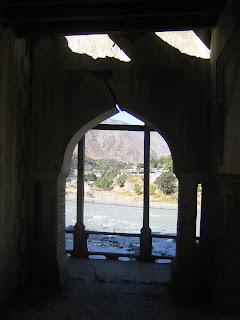The houses in the village are mainly traditional, made out of wood, mud, water and stone. Many are built into the side of the mountain. A few times I was accidentally walking on house roofs rather than the mountain / fields, and the only way of telling was the smoke furling out of the chimney!
 In an interesting juxtaposition, some houses had satellite dishes fixed to their roofs. Twas very bizarre sitting in Asif's very traditional house in the middle of the Hindu Raj mountains and watching a French film channel and German news.
In an interesting juxtaposition, some houses had satellite dishes fixed to their roofs. Twas very bizarre sitting in Asif's very traditional house in the middle of the Hindu Raj mountains and watching a French film channel and German news.The traditional houses usually have a large boundary around them, within which there are three buildings - the actual family house, a guest house and the cattle shed. The surrounding land is used for the animals. The guest house is usually a modern building, light and very colourfully designed inside. This really emphasizes the importance that Chitrali families place on entertaining guests well. Asif had built his guest house that I stayed in, and it was beautiful. In contrast the family houses were very traditional. The entrance was usually narrow, small and dark, and then you follow a small and dark corridor and enter the main room - which is the living area, the kitchen and the sleeping area. In the centre is the wood stove which provides all heating, hot water and where all the cooking is done. Around the stove is the sitting area where we have meals, and around that is the sleeping area. Whole extended families of ten people or more live in these houses. Eating with Asif's family was a real experience and very atmospheric - children, parents and grandparents were all crowded around the stove, and fresh meat, chappatis and vegetables were served on a cloth on the floor. Often we were eating by gaslight because the village hydro-electric power plant had broken.
 The houses are very strongly built and withstand the frequent earthquakes in the area. Asif showed me a house that he said was over 600 years old. It was also designed so that it could withstand attacks from Nuristani bandits. Within the house the corridor was complicated, narrow and dark with sudden turns to put off any attackers:
The houses are very strongly built and withstand the frequent earthquakes in the area. Asif showed me a house that he said was over 600 years old. It was also designed so that it could withstand attacks from Nuristani bandits. Within the house the corridor was complicated, narrow and dark with sudden turns to put off any attackers: The main room was well hidden at the back of the house.
The main room was well hidden at the back of the house.Interesting aspects of local history are passed orally down the generations. For example, when we drove over the Shandur pass Asif showed me a stretch of land where he said that the people of his village met and welcomed a British force under Colonel Kelly. They welcomed the British because they did not like the Chitrali rulers against whom the British were fighting. I have since read that Colonel Kelly led a force of troops from Gilgit over the 12,000 ft Shandur pass in deep snow and impossibly difficult conditions to relieve a British force being sieged in Chitral city. I visited the fort in Chitral where the British were being sieged for several months. Unfortunately the fort is tumbling down now.

Two final observations remain: education was considered very important in the village. There were about nine primary schools for boys and girls in Asif's village alone, and some of the children walked eight miles a day to attend a particularly good school. And secondly, people in the village obviously collaborted a lot so that basic services could be provided in the village. Government interventions were not much in evidence in the village at all - most of the schools were community or NGO run, one road had been built by the community, and there was no electricity provided by the government. So, supported by an NGO, community members were busy building a new hydro-power plant which I visited.

No comments:
Post a Comment